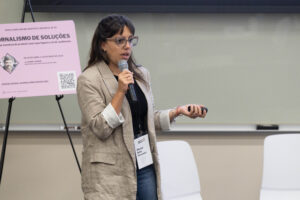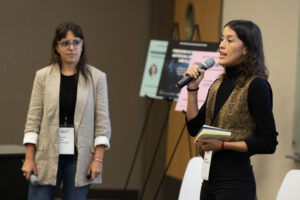April 22, 2024 | Business Models, Coloquio, Digital Native Media, ISOJ2024
Los medios deben manejar sus números y llevar registro del trabajo que hacen a diario, dijeron representantes de SembraMedia
Read this article in English below
¿Cuántas notas publicó tu medio en el último año? ¿Cuánto dinero ha ganado tu medio en el último año? ¿Qué impacto generaron tus notas en tu comunidad? ¿Qué evidencias tienes de que tu medio logra lo que dice que logra?
Con estas preguntas Micaela Fernández y Chiara Finocchiaro, directora de finanzas y project manager de SembraMedia respectivamente, dieron inicio a su presentación sobre finanzas y la importancia de medición en medios digitales en el 17º Coloquio Iberoamericano de Periodismo Digital celebrado el 14 de abril.
Para ellas es importante que cada periodista pueda responder a estas preguntas para así cumplir con la premisa que ha tenido SembraMedia a los largo de sus 10 años de funcionamiento: “Nunca hagas nada sin antes estudiarlo primero”. Además, consideran importante que los líderes de medios y periodistas manejen sus números, conozcan de contabilidad y se sientan cómodos hablando de finanzas.

SembraMedia es una organización sin fines de lucro que tiene como misión potenciar voces diversas de habla hispana en Latinoamérica, España, Estados Unidos y Canadá para que puedan sostener su independencia, calidad periodística e impacto positivo en la ciudadanía.
“Estamos continuamente estudiando el ecosistema, acompañando a los medios, viendo las fortalezas, los riesgos, las amenazas que se presentan y en base a esto arrancamos con nuestro trabajo”, dijo Fernández.
Como parte de este estudio constante, SembraMedia ha podido notar que existe, en la actualidad, en los medios una falta de medición y de registro del trabajo que se hace a diario.
“Muchas veces lo que nos mueve profundamente a los periodistas es nuestra convicción por nuestra profesión. Siempre estamos detrás de alguna historia que contar y, muchas veces, en esta vorágine de resolver las tareas operativas y de la agenda diaria perdemos mucho foco y casi siempre el negocio viene después, queda postergado”, explicó Finocchiaro.
A lo largo de la presentación las ponentes enfatizaron que la única manera de conocer si el trabajo de los periodistas está funcionando y llegando a las audiencias es conociendo y analizando los números. Y no solo se refieren a las métricas de cuántas personas están dando clic a las historias ni los seguidores en redes sociales, sino también a los registros de tiempo invertido e impacto.
Entre los ejemplos de cosas que se pueden medir dentro del medio están el registro de procesos nuevos implementados, cuántas actividades de conexión con la audiencia se realizaron, impactos tangibles dentro de la comunidad como cambios en alguna legislación, etc.

En cuanto al área de finanzas, según dijo Fernández, es clave poder medir los ingresos y egresos del medio. También se pueden medir las nuevas alianzas con otros medios u organizaciones, nuevos contratos, entre otros.
“Todo se puede medir pero mejor empezar por las finanzas, los equipos y procesos, y los impactos”, dijo Fernández.
Para SembraMedia la medición le permitirá a los medios y periodistas tomar decisiones estratégicas e informadas y con propósito claro, conocer mejor su medio y trabajo, conectar mejor con la audiencia, conocer los cambios que se logran en las comunidades, rendir cuentas a financiadores, respaldar con evidencia y hasta aumentar la autoestima profesional.
Fernández y Finocchiaro cerraron su presentación invitando a los asistentes a visitar los recursos y guías de aprendizaje de SembraMedia y dando una conclusión final: “Medimos para conocer por qué hacemos lo que hacemos y tomar mejores decisiones”.
El Coloquio Iberoamericano de Periodismo Digital es un encuentro anual de periodistas de la región que organiza el Centro Knight para el Periodismo en las Américas. Tradicionalmente se celebra el domingo siguiente a la clausura del Simposio Internacional de Periodismo Online (ISOJ) y este año tuvo lugar el 14 de abril. Puede encontrar una grabación del Coloquio aquí.
Media must manage their numbers and keep records of the work they do on daily basis, according to SembraMedia
How many stories did your media outlet publish in the last year? How much money has your media outlet earned in the last year? What impact did your article have in your community? What evidence do you have that your media outlet achieves what it says it achieves?
With these questions Micaela Fernández and Chiara Finocchiaro, finance director and project manager of SembraMedia, respectively, began their presentation on finance and the importance of metrics in digital media at the 17th Ibero-American Colloquium on Digital Journalism held on April 14.
For them, it is important that each journalist can answer these questions in order to comply with the premise that SembraMedia has had throughout its 10 years of operation: “Never do anything without studying it first.” Additionally, they consider it important that media leaders and journalists manage their numbers, know accounting, and feel comfortable talking about finances.
SembraMedia is a non-profit organization whose mission is to promote diverse Spanish-speaking voices in Latin America, Spain, the United States and Canada so that they can sustain their independence, journalistic quality and positive impact on citizens.
“We are continually studying the ecosystem, working alongside the media, seeing the strengths, the risks, the threats that arise and, based on this, we start our work,” Fernández said.
As part of this constant study, SembraMedia has been able to notice that there is currently a lack of measurement and recording of the work done daily in media.
“Many times what moves us journalists deeply is our conviction for our profession. We are always after some story to tell and, many times, in this maelstrom of solving operational tasks and the daily agenda we lose a lot of focus and almost always the business comes later, it is postponed,” Finocchiaro said.
Throughout the presentation, the speakers emphasized that the only way to know if the journalists’ work is working and reaching audiences is by knowing and analyzing the numbers. And they not only refer to the metrics of how many people are clicking on the stories or following along on social networks, but also to the records of time spent and impact.
Examples of things that can be measured within the media outlet include the record of new processes implemented, how many audience connection activities were carried out, tangible impacts within the community such as changes in legislation, etc.
Regarding the area of finance, according to Fernández, it is key to be able to measure the media outlet’s income and expenses. New alliances with other media or organizations, new contracts, among others, can also be measured.
“Everything can be measured but it is better to start with finances, equipment and processes, and impacts,” Fernández said.
For SembraMedia, measurement will allow media and journalists to make strategic and informed decisions with a clear purpose, know their media and work better, connect better with the audience, know the changes that are achieved in the communities, be accountable to financiers, support with evidence and even increase professional self-esteem.
Fernández and Finocchiaro closed their presentation by inviting attendees to visit SembraMedia’s resources and learning guides and giving a final conclusion: “We measure to understand why we do what we do and make better decisions.”
The Ibero-American Colloquium on Digital Journalism is an annual meeting of journalists from the region that is organized by the Knight Center for Journalism in the Americas. It is traditionally held the Sunday following the close of the International Symposium on Online Journalism (ISOJ) and this year was held on April 14. A recording of the Colloquium can be found here.

